Stresa
Stresa | |
|---|---|
| Comune di Stresa | |
 Stresa and Lake Maggiore | |
| Coordinates: 45°53′N 8°31′E / 45.883°N 8.517°E | |
| Country | Italy |
| Region | Piedmont |
| Province | Verbano-Cusio-Ossola (VB) |
| Frazioni | Brisino, Carciano, Levo, Binda, Passera, Someraro, Vedasco, Magognino, Stropino, Alpino, Mottarone, Isola Bella, Isola Pescatori. |
| Government | |
| • Mayor | Giuseppe Bottini |
| Area | |
| • Total | 33 km2 (13 sq mi) |
| Elevation | 200 m (700 ft) |
| Population (30 September 2008)[2] | |
| • Total | 5,155 |
| • Density | 160/km2 (400/sq mi) |
| Demonym | Stresiani |
| Time zone | UTC+1 (CET) |
| • Summer (DST) | UTC+2 (CEST) |
| Postal code | 28838 |
| Dialing code | 0323 |
| Patron saint | Ambrose |
| Website | Official website |
Stresa is a town and comune of about 5,000 residents on the shores of Lake Maggiore in the province of Verbano-Cusio-Ossola in the Piedmont region of northern Italy, about 90 kilometres (56 mi) northwest of Milan. It is situated on road and rail routes to the Simplon Pass.
History

The name of this town first appeared in documents in AD 998.
In the 15th century, it grew into a fishing community and owed feudal allegiance to the Visconti family. It subsequently came under the control of the Borromeo family. In 1948 American author and journalist Ernest Hemingway visited the town. He had set part of his 1929 novel Farewell to Arms in the Grand Hotel des Iles Borromees. In 2002 Stresa hosted the 10th International Hemingway Conference.
Stresa has played host to a number of political conferences in the 20th century, including in:
- 1935: the UK, Italy and France re-affirm the Treaty of Locarno and agree to form the Stresa front to combat and contain Nazi Germany.
- 1958: the foundations of what would become Europe's Common Agricultural Policy of the European Economic Community were formulated in Stresa.
Stresa is also the venue for the "Settimane Musicali"; an international classical music festival which is held annually in the summer.

Transport
Regular boat services from the town's two docks provide access to the nearby Borromean Islands. The cable-car offers a 20-minute ride to the summit of Monte Mottarone, with the Giardino Botanico Alpinia en route. Eurocity services connect to Milano, Berne and Geneva.
Main sights

- Villa Ducale, commissioned by Giacomo Filippo Bolongaro and dating from about 1770. In 1848 the villa passed to the Italian philosopher Antonio Rosmini-Serbati and today it houses the International Centre for Rosminian Studies.
- Villa Dell'Orto, built in 1900. It was commissioned by the painter Liberto Dell'Orto and designed by Boffi.
- The large Villa Pallavicino, between Stresa and Belgirate. It was the inspiration of Ruggero Bonghi in the 1850s and now is the site of a zoological park.
- The church of S. Ambrogio (restored in Neoclassical style by Giuseppe Zanoia in 1790)
Famous buildings of Stresa in movies
- Villa Castelli, location of the black comedy Beati i ricchi (Blessed Are the Rich) (1972) by Salvatore Samperi, the TV movie horror Ho incontrato un'ombra (1974) by Daniele D'Anza, the thriller The Bishop's Bedroom (La stanza del vescovo) (1977) by Dino Risi and the drama La Sapienza (2014) by Eugène Green.
- Hotel Regina Palace, location of Totò al giro d'Italia (1948) by Mario Mattoli, Miss Italia (1950) by Duilio Coletti, Grand Hotel Excelsior (1982) by Castellano & Pipolo.
(Information from the Dizionario del Turismo Cinematografico)
External links
- Official site (in Italian)
- Stresa Festival - Settimane Musicali di Stresa e del Lago Maggiore (in English)
- Stresa.Net – tourist information (in English)
- Visit Stresa – tourist information (in English)
- ^ "Superficie di Comuni Province e Regioni italiane al 9 ottobre 2011". Italian National Institute of Statistics. Retrieved 16 March 2019.
- ^ "Popolazione Residente al 1° Gennaio 2018". Italian National Institute of Statistics. Retrieved 16 March 2019.





